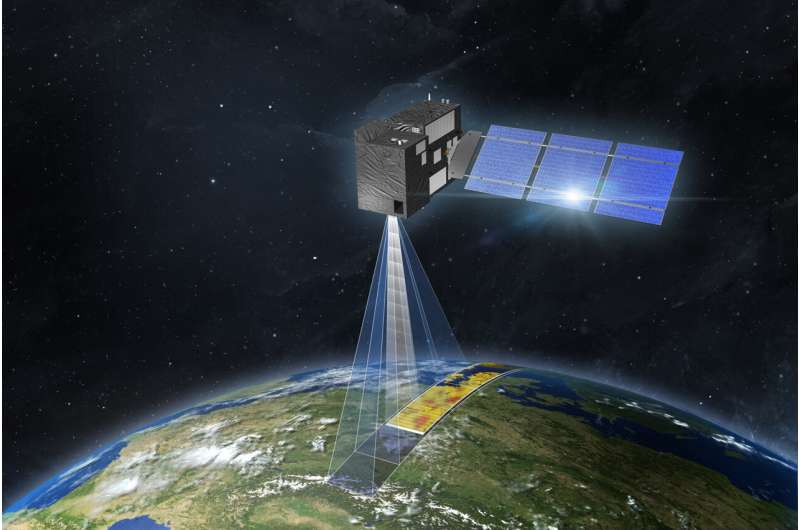Carbon dioxide monitoring satellite being tested against launch stresses

A new satellite destined to be Europe's prime mission for monitoring and tracking carbon dioxide emissions from human activity is being put through its paces at ESA's Test Centre in the Netherlands. With nations at COP26 pledging net-zero emissions by 2050, the pressure is on to reduce the amount of greenhouse gases we pump into the atmosphere—but the race is also on to support the monitoring that shows targets are being met. ESA, the European Commission, Eumetsat and industrial partners are therefore working extremely hard to get the Copernicus Anthropogenic Carbon Dioxide Monitoring mission ready for liftoff in 2025.
As the reality of climate change is hitting hard, the target of limiting global temperature rise to 1.5°C is critical if we have any hope combating climate change—and the best way of doing this is to reduce greenhouse emissions. However, understanding that targets are being met is also a priority—and the best way of doing this is from space.
The Copernicus Anthropogenic Carbon Dioxide Monitoring mission, or CO2M for short, is one of six Copernicus Sentinel Expansion missions that ESA is developing on behalf of the EU. These high-priority missions will address EU policy and gaps in Copernicus user needs, expanding the current capabilities of the Copernicus program—the world's biggest supplier of Earth observation data.
CO2M is planned as a two-satellite mission, with the option of a third satellite. They each will carry a near-infrared and shortwave-infrared spectrometer to measure atmospheric carbon dioxide at high spatial resolution. These measurements will be used by the new CO2M Monitoring and Verification Support Capacity, which the European Centre for Medium-Range Weather Forecasts is developing, and which will eventually reduce uncertainties in estimates of emissions of carbon dioxide from the combustion of fossil fuel at local, national and regional scales.
This will provide the EU with a unique and independent source of information to assess the effectiveness of policy measures, and to track their impact towards decarbonising Europe and meeting national emission reduction targets.
Moreover, nations throughout the world will be able to assess and compare with transparency how they are meeting their targets.
Yasjka Meijer, CO2M Mission Scientist at ESA, said, "Remarkably, the mission will enable us to distinguish between natural sources of carbon dioxide and sources that are a result of human activity. This is no easy matter because the carbon dioxide in the atmosphere comes from many sources, but each source only contributes a small amount. We need to measure very precisely if the mission is going to provide reliable data to ensure that governments are meeting their targets."
With such an important task ahead, the development of CO2M is running at full speed and the industrial team is working hard to get the satellite ready for its life in orbit.
As part of the development, the satellite structural model is at ESA's ESTEC testing facilities in the Netherlands—the largest satellite test facility in Europe, equipped to simulate every aspect of the space environment. The shakers are used specifically to simulate launch stresses.
Valerie Fernandez, ESA's CO2M Project Manager, explains, "Everyone is working hard to keep the development of the mission running to a tight schedule. The current suite of tests is being carried out on the structural model of the satellite at ESTEC. It is now on a shaker, which tests the satellite's mechanical integrity to make sure that it is sufficiently rigid and will survive the vibrations of launch.
"These tests will allow us to consolidate the satellite design and move quickly towards the next steps in the hardware procurement. Although we have to work as efficiently as possible, the team is being very careful and thorough to ensure that CO2M will be a world class mission and something Europe can be extremely proud of."
Provided by European Space Agency





















